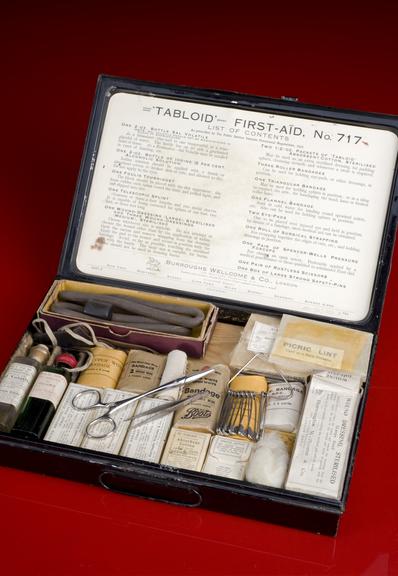Bottle of spirit of sal volatile prepared by Burroughs Wellcome and Co.
Bottle of spirit of sal volatile prepared by Burroughs Wellcome and Co., London, 1931-1932

"Tabloid" first aid kit, No.717, for public service vehicles, in japanned metal case, by Burroughs Wellcome and Co., London, 1931-1932
‘Tabloid’ was a brand patented by Henry Wellcome in 1884 and was used for a wide range of Burroughs, Wellcome & Co products, such as this first aid kit. It was later extended to other products such as first aid kits. The word ‘tabloid’ referred to the compressed nature of the drugs. This medical meaning may be lost to time, but the word remains in common usage in the newspaper trade.
This kit was designed for public service vehicles such as buses, trams and trains. The kit contains equipment to treat minor injuries: bandages, a tourniquet to stem heavy bleeding, burn dressings, a splint to stabilise bone fractures, a pair of artery forceps and smelling salts used to bring around someone who has fainted.
Bottle of spirit of sal volatile prepared by Burroughs Wellcome and Co., London, 1931-1932
Bottle of alcoholic solution of iodine, green ribbed poison bottle, by Burroughs Wellcome and Co., London, 1931-1932
Packet, cellophane, split, containing three triangular bandages and 2 eye pads, prepared by Burroughs Wellcome and Co., London, 1931-1932
Part of flannel(?) bandage
Eye pad patch, cloth, by Burroughs Wellcome and Co., London, 1931-1932
1 Foulis tourniquet, rubber and vulcanite, in cardboard box
Picric lint burn dressing
Spencer Wells artery forceps, plated metal, foreign, 1925-1932
Artery forceps are used to control bleeding from blood vessels by clamping down on the artery. A locking mechanism at the handle keeps them in place. Helped by surgical instrument makers, surgeons developed their own tools, often naming them after themselves. Thomas Spencer Wells (1818-1897) was an English surgeon who became surgeon to Queen Victoria between 1863 and 1896. He developed the rachet locking mechanism holding the forceps in position. His second design had shorter jaws to increase compression and were ridged to improve grip. By being held closed, they could also not get trapped in the body's tissues or muscles. Prior to Spencer Wells' designs, an assistant had to hold the forceps closed.
Spencer Wells specialised in eye and obstetric surgery and was an early adopter of anaesthetics. He developed the operation to remove ovaries and ovarian cysts but was vocal that it should be performed only if necessary.
Tweezers, plated metal, made in Sheffield, English, 1925-1932
Finger sheath, leather, with securing tapes
Some safety pins, in tin, by Burroughs Wellcome and Co., London, 1931-1932
Some safety pins on triangular loop holder
4 packets, 3 small & 1 large, of sterilized wound dressing made by Burroughs Wellcome and Co., London, 1931-1932
2 packets of "Tabloid" cotton wool, made by Burroughs Wellcome and Co., London, 1931-1932
4 rolls of white open wove bandage, of varying size
2 rolls of fine white open wove bandages, of different size, by Boots Drug Co. Ltd., English, 1925-1932
Japanned metal case with leaflet issued by Ministry of Agriculture, Food & Fisheries & Scottish Agriculture, for,"Tabloid" first aid kit, No.717, for public service vehicles by Burroughs Wellcome and Co., London, 1931-1932